Extreme Trek Tech!
:: Will the real world evolve to resemble the Star Trek universe, or is it all just extreme-tech escapism for people who can't deal with reality?
++ Trek Tech: USA / David Allen Batchelor / The Science of Star Trek
On March 11, 1964, Gene Roddenberry wrote a 16-page draft pilot for a show he told network executives would be a "Wagon train to the stars," in homage to the many popular Westerns of the time.
 Later that year, shooting began on the first "Star Trek" episode. In June, 1969, the last episode aired a little more than a month before the first man walked on the moon. In syndication, Star Trek became one of the most successful franchises in the history of the entertainment industry! [Image Credit: Franz Joseph / Vektor / Ivor The Engine / Don Cook's Digital Café]
Later that year, shooting began on the first "Star Trek" episode. In June, 1969, the last episode aired a little more than a month before the first man walked on the moon. In syndication, Star Trek became one of the most successful franchises in the history of the entertainment industry! [Image Credit: Franz Joseph / Vektor / Ivor The Engine / Don Cook's Digital Café]"Star Trek" has influenced a generation of engineers and scientists, inspiring them to "boldly go" forward in an attempt to participate in the utopian future they saw on TV.
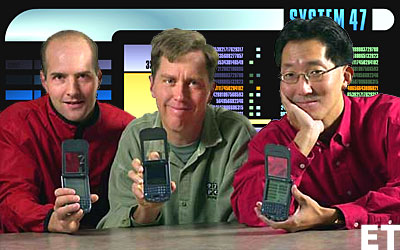
"When I designed the UI (User Interface) for the Palm OS back in '93, my first sketches were influenced by the UI of the Enterprise bridge panels,'' said Rob Haitani, product design architect for Palm-One Inc., the Milpitas firm that makes the popular handheld personal computers. "Years later, when we designed the first Treo (a combo phone and wireless PDA), it had a form factor similar to the communicators in the original series. It had a speakerphone mode so you could stand there and talk into it like Capt. Kirk.'' [Image Credit: Kim Komenich / Chronicle | Don Cook's Digital Café]
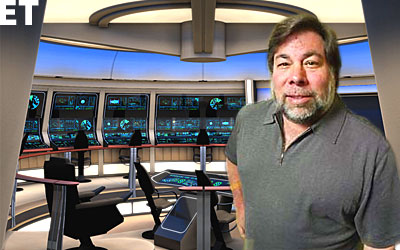
"I went to Star Trek conventions. During my Apple design days I’d come home to my apartment, from work at nearby HP, to watch Star Trek (reruns) and then head back to HP to work late . . ." ~Quote from a "Techie" who is a "Trekkie": Steve Wozniak, Apple Co-founder! [Image of Steve Wozniak: John Todd / AP | Image Credit: Don Cook's Digital Café]
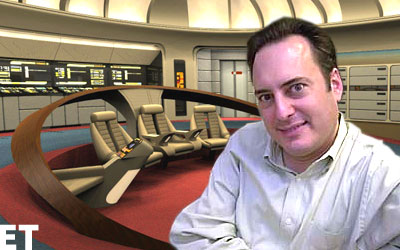
"On Star Trek, computers were ubiquitous, running everything from life-support systems to long-range sensors. The voice-activated computer gave any crew member instant access to a database containing the recorded histories of Earthlings, Vulcans, Romulans and other known life forms. Episodes contemplated technology that could create an artificial reality. This was hugely inpiring to me, and it’s one of the things that drove me into exploring computer graphics, motion capture, and audio perception." ~Steve Perlman, Silicon Valley entrepreneur and founder of WebTV. [Image of Steve Perlman: Kurt Rogers / Chronicle | Image Credit: Don Cook's Digital Café]
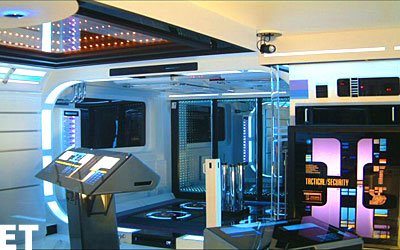 No article about the "Tech of Trek" would be complete without reference to the influence that Star Trek has had on interior design. One example is the coolest apartment on earth (and maybe in the 'verse)! Designed and built by interior designer Tony Alleyne, of 24th Century Interior Design, this Star Trek Apartment has made world news and been featured on many television and radio shows around the world. Note: This apartment is for sale! Price: A cool $2 million (and, of course, you will have to move to the UK). [Image credit: Tony Alleyne]
No article about the "Tech of Trek" would be complete without reference to the influence that Star Trek has had on interior design. One example is the coolest apartment on earth (and maybe in the 'verse)! Designed and built by interior designer Tony Alleyne, of 24th Century Interior Design, this Star Trek Apartment has made world news and been featured on many television and radio shows around the world. Note: This apartment is for sale! Price: A cool $2 million (and, of course, you will have to move to the UK). [Image credit: Tony Alleyne]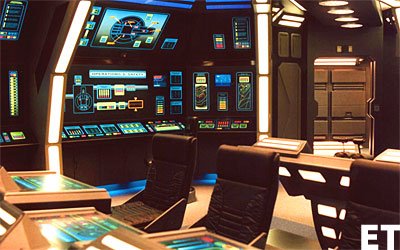 Another designer who is doing great SF interiors is Julie Bolder. She is a production designer with over 10 years experience designing sets for episodic TV, features and commercials. [Image credit: Julie Bolder]
Another designer who is doing great SF interiors is Julie Bolder. She is a production designer with over 10 years experience designing sets for episodic TV, features and commercials. [Image credit: Julie Bolder]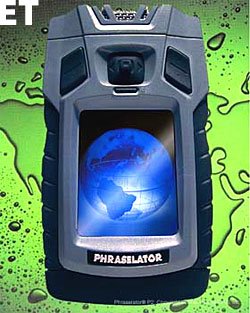 Trek Tech: Universal Translater. Whenever a new alien race was discovered, a device built-in to the ship's computer and their personal communicators, called a Universal Translator, would allow them to communicate with species that have different languages, vocabularies (and dialects).
Trek Tech: Universal Translater. Whenever a new alien race was discovered, a device built-in to the ship's computer and their personal communicators, called a Universal Translator, would allow them to communicate with species that have different languages, vocabularies (and dialects).This was an important plot device, since the majority of episodes would involve communicating with alien species.
Today our own military communicates with a different type of "alien" (Afghans and Iranians) using a translation device called the Phraselator.
Various dialects are programmed into the device, and when an "alien" speaks into it, a computer voice translates their speech into English and vice versa.
 Trek Tech: Non-Invasive Surgery. McCoy was able to perform surgeries without cutting into someone's body. Blade-free surgery is now possible with equipment like the CyberKnife, developed at Stanford University. (There are also non-invasive laser surgeries for treating kidney stones or prostate inflammations.) [Image credit: CyberKnife Society | Don Cook's Digital Café]
Trek Tech: Non-Invasive Surgery. McCoy was able to perform surgeries without cutting into someone's body. Blade-free surgery is now possible with equipment like the CyberKnife, developed at Stanford University. (There are also non-invasive laser surgeries for treating kidney stones or prostate inflammations.) [Image credit: CyberKnife Society | Don Cook's Digital Café]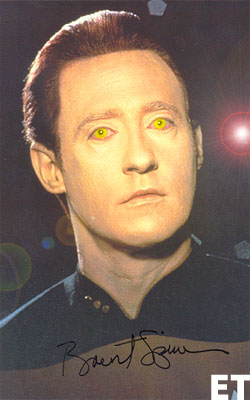 Trek Tech: Yellow Eyes. "Do Androids Dream of Electric Sheep" was a short story by Philip K. Dick, that the exceptional movie "Blade Runner" was based upon.
Trek Tech: Yellow Eyes. "Do Androids Dream of Electric Sheep" was a short story by Philip K. Dick, that the exceptional movie "Blade Runner" was based upon.An important research organization for robotics is the American Association for Artificial Intelligence. At a recent conference on cybernetics, the president of the Association was asked what is the ultimate goal of his field of technology. He replied, "Lieutenant Commander Data."
Creating Star Trek's Mr. Data would be a historic feat of cybernetics, and right now it's very controversial in computer science as to whether or not it can be done.
Maybe a self-aware computer can be put into a human-sized body and convinced to live sociably with us and our limitations. This is far in advance of our current computer technology, but may be possible.
By the way, Data's "positronic" brain circuits are named after the circuits that Dr. Isaac Asimov (the inventor of the three laws of robotics) imagined for his fictional robots.
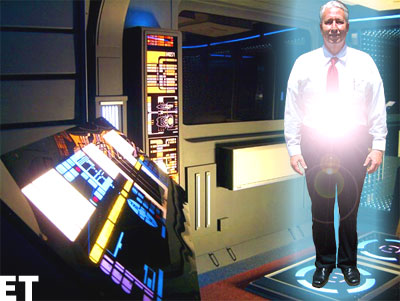 Trek Tech: Spooky Action. In the future universe of Star Trek, transporters can make a precise image of every particle in a person or object, convert these into a stream of matter (or energy), focus this stream on a precise destination and reassemble these particles in its original form. [Image Credit: Tony Alleyne / Don Cook's Digital Café]
Trek Tech: Spooky Action. In the future universe of Star Trek, transporters can make a precise image of every particle in a person or object, convert these into a stream of matter (or energy), focus this stream on a precise destination and reassemble these particles in its original form. [Image Credit: Tony Alleyne / Don Cook's Digital Café]Lawrence Krauss, author of The Physics of Star Trek, claims that transporting a person is not possible.
However, researchers at the California Institute of Technology, Aarhus University in Denmark and the University of Wales have all achieved real teleportation. What they transported wasn't any person or object - it was the quantum property of a photon or light particle.
Quantum mechanics is the study of things that are very, very small. In the Quantum universe, things can go against everything we know about physics. One particularly strange feature is called "entanglement". When you create two particle twins from a single sub-atomic particle, the quantum properties of each particle will always be opposite, no matter how far apart they get. Change one, you instantly change the other - even if the particles are at opposite sides of the universe, the change will be instantaneous. Albert Einstein called this "spooky action at a distance."
This paradox has existed on paper for more than 50 years. But it wasn't until more recently that researchers were able to prove this process actually works, that it's been happening in nature since the dawn of time and that it could be exploited by humans to achieve bona fide teleportation!
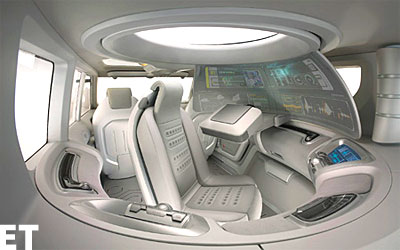 Trek Tech: Shuttlecraft. Nissan of Europe has designed a Star Trek shuttlecraft inspired concept car, called the Terranaut. If your office is the great outdoors, this vehicle might be the perfect one for you. Designed for “scientists, geologists, archaeologists, and adventurers” (which pretty much describes a good portion of the Enterprise crew), it seats three people and features a spherical laboratory that has a seat that swivels 360 degrees in order to give the intrepid scientist (and/or explorer) access to all of the vehicle's workstations.
Trek Tech: Shuttlecraft. Nissan of Europe has designed a Star Trek shuttlecraft inspired concept car, called the Terranaut. If your office is the great outdoors, this vehicle might be the perfect one for you. Designed for “scientists, geologists, archaeologists, and adventurers” (which pretty much describes a good portion of the Enterprise crew), it seats three people and features a spherical laboratory that has a seat that swivels 360 degrees in order to give the intrepid scientist (and/or explorer) access to all of the vehicle's workstations.Terranaut has enough refrigerated storage space to house food, water and other provisions for stays of upwards of a week out in the field. Lightweight tents, and sleeping bags built for extreme conditions and simple cooking facilities are carried in storage compartments in the doors. [Source: Nissan Europe]
Note From Technophile: The Star Trek series was probably the only SF series crafted with respect for real science and physics (although sometimes they did get the scientific details wrong), with ideas designed not only to entertain, but to expand the mind as well, and stories written intelligently with an effort to be faithful to humanity's greatest achievements. Star Trek has had probably the greatest influence on real-world science and technology, and ET (Extreme Technology) of any SF series.:: Source: [The Science of Star Trek]
:: Image Credits: [Kim Komenich | Julie Bolder | Tony Alleyne | Kurt Rogers | John Todd | Franz Joseph | Vektor | Ivor The Engine | Don's Digital Café]
:: Innovation: To "boldly go where no one has gone before" and shape future technology based on ideas from popular SF!
:: Available: Now and into the foreseeable future.
:: Cost: Unknown.
". . . a dream that became a reality and spread throughout the stars" ~ James T. Kirk (from the episode, "Whom Gods Destroy")More to follow on the "tech of trek" (as I have time): Star Trek punk rockers, matter-antimatter power generation, impulse engines, alien beings, sensors (and tricorders), deflector shields, tractor beams, artificial gravity, subspace communications, phasers, healing rays, replicators, holodecks, warp (interstellar) drives, and time travel!
Regards, Technophile

Note from Dan Lelevier, ET (Extreme Technology) Consumer Product Advisor: This year, "Star Trek" celebrates its 40th Anniversary of the Original Series. The "Star Trek Store" is the official "Star Trek" franchise e-commerce site, and contains the largest selection of official and licensed "Star Trek" items available online. Items range from DVDs, collectibles, clothing, books, autographs from cast members, comics, action figures, model kits, etc, etc., etc. This "Super Star Trek Store" includes items from ALL the television series and movies. Experience more "Extreme Trek Tech" by clicking on the banner below:



















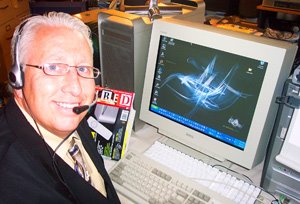
0 Comments:
Post a Comment
<< Home